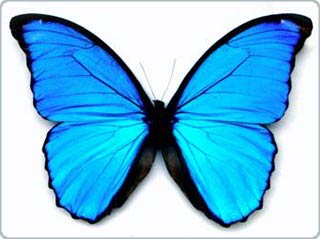Learn how to make flat screens from butterflies
Butterflies can produce many strange colors thanks to the crystal scales on their wings. If they mimic their coloring, humans can create a new kind of flat panel display at a very low cost.
The materials used in this technique can be found easily in nature, much cheaper than the materials used to produce screens in today's factories.

Cyanophrys remus.(Photo: Newscientist)
The scientific work supporting these ideas is carried out by a group of American and European researchers. They examined the structure and properties of the luminescent crystals in the wings of the butterfly Cyanophrys remus .
Physical luminescent crystals have a periodic structure with the same size and wavelength of light. Thanks to these properties, when a ray of light hits the crystal, it will interfere in certain directions and frequencies.
Scientists believe that the optical crystal scales on the wings of some butterflies have produced their colors. These crystal scales are made up of chitin, a type of polysaccharide that exists in insects and some animals. At a width of a few tens of thousands of millimeters, they are arranged on the wing surface like the tile layers of a roof.
The wings of the male butterfly Cyanophrys remus are bright blue on one side - thought to attract the attention of female butterflies - and dark green on the other side to disguise. "It's amazing that wings can create a lot of colors," said Lazlo Biro, a material scientist at the Institute of Applied Physics and Materials Science, Budapest, Hungary.
Biro and his colleagues photographed luminescent crystal scales on butterfly wings by electron microscopy, then looked at how they reflected light. They discovered that crystal scales on both sides of the same wing had different structures. Scales are composed of luminescent single crystals that produce a bright blue color, while dark green is the result of a random arrangement of luminescent polycrystalline crystals.
The random arrangement structure in crystals can be applied in many areas. Crystal particles can produce many colors - green, yellow and blue - depending on their direction. But the result of countless crystal beads on the wings of the Cyanophrys remus butterfly is dark green. The team also found a way for the crystal to produce red reflecting light.
Biro claims that the green-red-blue palette can be used in flat-panel manufacturing technology by creating a series of crystals on the electronic arms so that they can change directions. That way, each crystal - corresponding to a pixel - can emit red, green or blue. The basic three-color self-luminous ability is the foundation in color screen technology.
Viet Linh
- Learn about flat foot syndrome - the cause and treatment
- Learn the terrible eating habits of butterflies
- Beautiful butterflies
- How to make a moth into a butterfly?
- Butterfly's wicked secret
- Samsung will produce touch screens for hybrid phones
- Butterflies are beautiful like fairytale in Mexico
- Giant butterflies appear much in Soc Trang
- Fluttering because of dozens of butterflies
- Instructions on how to change the flat interface for Facebook on your computer
- The point of incredible facts about green butterflies
- Coming soon graphene smartphone screen 'can't break'
 Why do potatoes have eyes?
Why do potatoes have eyes? 'Tragedy' the world's largest carnivorous life: Death becomes ... public toilet
'Tragedy' the world's largest carnivorous life: Death becomes ... public toilet Tomatoes were once considered 'poisonous' for 200 years
Tomatoes were once considered 'poisonous' for 200 years Detecting microscopic parasites on human face
Detecting microscopic parasites on human face